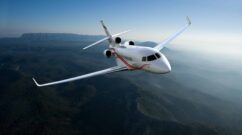The conclusion is indisputable: we will no longer travel tomorrow as we do today. Driven by a movement of ecological transition, the consumption patterns of business aviation differ and new aspirations are flourishing. From now on, technological attempts are emerging to develop jets that are more efficient, but above all more durable and much less polluting. We are therefore witnessing a de-carbonisation of the air, a collective challenge for companies that are proving to be more and more fuel efficient.
Private jets: allies or enemies of the climate?
There is no longer any need to demonstrate that a real ecological awareness has developed in recent years. More than ever, modes of transport are being questioned, rethought and optimised in order to reduce the famous “carbon footprint”. Business aviation is no exception to the rule and many are sceptical about the correlation between this discipline and ecology.
This comes as no surprise when you break down the price of an aeroplane ticket and the cost of fuel accounts for a quarter of it. According to the United Nations Climate Expert Group, 5% of CO2 emissions come from air traffic and business aviation accounts for 8% of this traffic. The players in the aviation sector must therefore redouble their efforts to innovate, mobilise and reinvent an eco-responsible mode of transport.
In concrete terms, how much does an aircraft consume?
It is difficult to answer this question directly because this consumption is specific to each aircraft model and depends on many factors. However, we can mention the following influential parameters: the service provided (number of passengers or tonnes of freight), the distance to be covered and the aircraft’s cruising speed.
As an example, take a long-haul aircraft such as an Airbus A350 travelling a distance of 800 km and with a take-off weight of 245 tonnes. For this flight, this model consumes 48 tonnes of fuel, which corresponds to 60,000 litres of petrol consumed.
Notable progress
Growing energy savings
For several years now, manufacturers have been working to reduce CO2 emissions from air traffic. Companies such as AirBus and Boeing are rightly investing in more fuel-efficient models such as the Airbus 220 or Boeing 787. In 2010, Airbus even launched a range of “Neo” aircraft, which refers to the “new engine option”, designed to alleviate this problem. This involves a redesign of the aircraft with refined ailerons at the wing tip and the choice of lightweight materials such as carbon composite, titanium and aluminium.
Some companies are turning to turboprop aircraft, which are less fuel-hungry. On average, private jets have the advantage of consuming only 3.5 litres of fuel per 10 kilometres per passenger. Thus, the “ecological top of the range” is imposing itself on the business aviation market with prestigious but low-polluting aircraft.
Green petrol for air transport
Among this progress, the marketing of a new type of aeronautical fuel is also noteworthy. The first batches of certified biofuels, composed of forest and agricultural waste, vegetable oils and beetroot, are now entering the market. If this option has already proved its worth in the automobile sector, it also represents a strong potential for aircraft. It is estimated that these biofuels reduce CO2 by up to 80% since it can be absorbed by plants. As part of the Lab’line programme, AirFrance had launched several Toulouse-Paris flights on board aircraft running on biofuel. Also, certain associations such as the General Aviation Manufacturers Association (GAMA) have agreed to develop a sustainable fuel that is more respectful of the environment.
A few examples of the players in this coalition are: Air BP, , Aviator, Bombardier, Dassault Aviation, Embraer, Gulfstream, Textron Aviation and World Fuel Services, Avfuel, Diamond Aircraft, etc.
If you are interested in these aircraft manufacturers, you will find our article on private jet manufacturers on this subject.
The challenge of a high-performance, zero-emission aircraft
In 2015, Eviation launches its “Alice“, a jet with 9 seats and 2 crew members promising a range of 1000 km without the slightest polluting emission. The electric plane can also fly at a cruising speed of 520 km/h and its recharging time is half the time of use. Powered by three 260 kW propellers, this aircraft appears to be one of the first viable 100% electric aircraft.
We can then wonder whether this technology could be envisaged on larger aircraft. The answer is yes: it is the next big step for aircraft manufacturers…
The category of electrical appliances: the solution for the near future?
To find out more about tomorrow’s eco-responsible airborne solutions, read our article on electric aircraft and private jets written for this purpose.
Because ecology is not a constraint but rather a responsibility, AEROAFFAIRES is also committed to an approach that is more respectful of our planet. Thanks to our SkyCO2 programme, 100% of the CO2 emissions produced by each private flight are offset by supporting the preservation of Peru’s primary forests. With AEROAFFAIRES, it is therefore possible to book a flight at the best rates, in complete safety and with a very low impact on the environment.
To charter your private jet, contact us 7/7 24H/24 at +33 (0) 1 44 09 91 82.






